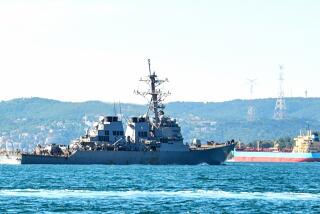Voyagers Sail Pacific as Ancient Polynesians Did
- Share via
HONOLULU — Using the stars as their compass and powered by the wind, voyagers in a traditional Polynesian sailing canoe have crisscrossed 20,000 miles of the vast Pacific, rediscovering ancient arts of sailing and navigation.
Since leaving more than a year ago with hopes of vindicating claims that Polynesians were sophisticated seafarers long before Westerners arrived, the 60-foot Hokule’a and its crew have traveled between Hawaii, Tahiti, New Zealand, American and Western Samoa and the Cook Islands.
The double-hulled vessel now sits on a beach in French Polynesia, awaiting its final journey back to Hawaii, where the voyage began.
“When we look back and into what the effort would take for what these ancient Polynesians did, it’s an amazing story,” navigator Nainoa Thompson said. “I think what Hokule’a has demonstrated is that we could sail these routes that we believe once were sailed.”
Seafaring Migrants
Archeological, linguistic and anthropological evidence indicates the region was settled by sophisticated seafaring migrants from Southeast Asia over a 2,000-year period ending in about AD 1,000, according to the Polynesian Voyaging Society, which sponsored the expedition.
Other theories contend that early seafarers could not have sailed eastward against prevailing winds in the area, and instead settled in the islands after drifting west from South America.
During the latest voyage, the crew of the Hokule’a hoped to provide support for the west-to-east migration theory. On July 10, 1985, the Hokule’a departed the tiny village of Milolii on the island of Hawaii.
The vessel sailed 3,000 miles south to Tahiti in 31 days, 700 miles west from Tahiti to the Cook Islands in 12 days, and 1,850 miles southwest to New Zealand in 16 days.
From New Zealand, the crew took seven days to sail 950 miles northeast to Tonga, then a day and a half to sail an additional 300 miles northeast to Western Samoa.
Aided by Favorable Winds
On the next leg, the crew, aided by favorable winds, sailed the Hokule’a nearly 1,200 miles east between Western Samoa and Tahiti in slightly more than two weeks.
“Our objectives were . . . clear. We wanted to find out if it could be done,” said Myron Thompson, president of the Polynesian Voyaging Society. “For certain now, we know the Polynesians were able to sail from west to east.”
For most of its voyage, the Hokule’a carried a crew of 12. The two hulls were lashed to a topside platform. Two crab-claw sails harnessed the often-variable Pacific winds. Provisions were carried in the hulls, where crew members also slept.
For safety, the Hokule’a was accompanied by the escort vessel Dorcas, which trailed the Hokule’a to avoid providing navigational clues. After completing each leg, some crew members flew back to Honolulu to rest and to spend time with their families before embarking on the next segment.
At many stops, the crew received traditional island greetings, and helped increase interest among Polynesians in their culture and history, Thompson said.
Interest in Voyaging
Recently, a group from Tahiti sailed to New Zealand in a traditional canoe, and residents of other Pacific islands also have expressed interest in voyaging, Thompson said.
For the Hokule’a, the current journey is its third.
In 1976 and 1980, the vessel was sailed from Hawaii to Tahiti and back. On the first voyage, Thompson assisted veteran Micronesian navigator Mau Piailug.
Piailug, who lives on the tiny island of Satawal in the Western Pacific, taught Thompson to judge direction by observing wave patterns generated by islands or land masses hundreds or thousands of miles distant.
On the second Hawaii-Tahiti trip, Thompson acted as lead navigator, assisted by Piailug.
Preparing for the current trip, Thompson spent hours in the Bishop Museum’s planetarium in Honolulu, studying the movement of stars in relation to the islands of the Pacific, deriving navigational cues that must have taken generations of observation by the ancient Polynesians.
‘They Were Exploratory’
“I think like all human beings, they were exploratory, and they tended to expand themselves,” said Thompson. “I mean, why (did the United States) go to the moon?”
Besides navigation, the ancient Polynesians must have been excellent seamen to be able to handle varying winds and heavy seas in rudimentary craft, Thompson said.
“For the guy that lived on an atoll, there wasn’t much difference between being on the atoll and being in his canoe,” Thompson said. “The sea was a tremendous part of him, where it is not for us.”
Some of those skills are being relearned, Thompson said, although on a modern vessel built of tough materials, and carrying the latest safety and emergency equipment.
“You can’t compare us to them; they were much greater sailors than we are,” Thompson said. “But the more we sail the better we get, and the better we get, the more we know.”
More to Read
Sign up for Essential California
The most important California stories and recommendations in your inbox every morning.
You may occasionally receive promotional content from the Los Angeles Times.











